Guide to Liverworts of Oregon: Blasia pusilla L.
HOME SPECIES INDEX GENUS INDEX GLOSSARY
1a plants thallose > 2b chloroplasts numerous > 62a thallus tissue homogeneous > 63b thallus ribbon like > 65a ventral scales present > Blasia pusilla
Synonym: None.
Special status: None.
Recognition: Bright green thalli, 1-3 mm wide, prostrate when sparse, erect when crowded, with round marginal lobes. The regular marginal lobes and embedded Nostoc colonies are distinctive. Large stellate gemmae on the dorsal surface are often prominent at the thallus apex, visible even without magnification, as are the gemma flasks. Gemmae from the flasks are irregularly polyhedral, not stellate. The Nostoc colonies are visible as dark green spots under a 10X handlens. They are otherwise found only in the hornworts, which do not present the regular ribbons of this species and have only a single chloroplast in their cells.
Distribution: Grows on soil; widespread but not common.
Comments: Sometimes weedy, as when growing on road cuts. Large colonies have been found on sand where a stream cuts through the coastal dunes.
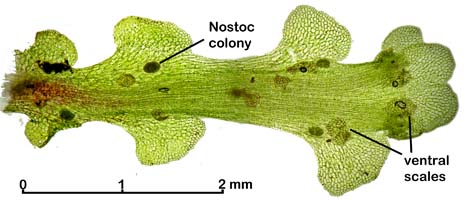 Blasia pusilla, ventral view. Sutton Beach, Lane Co., Oregon. DHW m2174a.
Blasia pusilla, ventral view. Sutton Beach, Lane Co., Oregon. DHW m2174a.
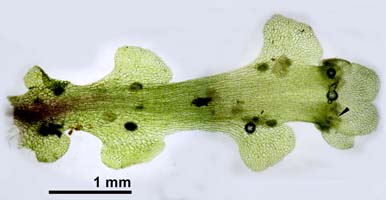 Blasia pusilla, dorsal view. Sutton Beach, Lane Co., Oregon. DHW m2174a. Pointer indicates archegonium.
Blasia pusilla, dorsal view. Sutton Beach, Lane Co., Oregon. DHW m2174a. Pointer indicates archegonium.
 Blasia pusilla, male plant. Cornwall, England. C. Callaghan 8 Aug 2022.
Blasia pusilla, male plant. Cornwall, England. C. Callaghan 8 Aug 2022.
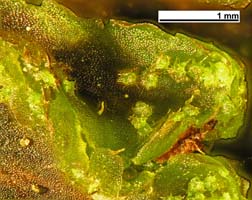 Blasia pusilla; Sutton Beach, Lane Co., Oregon. DHW m2412. Stellate gemmae on thallus surface.
Blasia pusilla; Sutton Beach, Lane Co., Oregon. DHW m2412. Stellate gemmae on thallus surface.
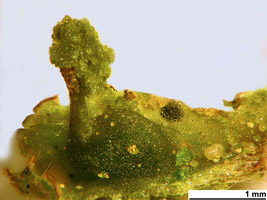 Blasia pusilla; Sutton Beach, Lane Co., Oregon. DHW m2412. Gemma receptacle on thallus.
Blasia pusilla; Sutton Beach, Lane Co., Oregon. DHW m2412. Gemma receptacle on thallus.
 Blasia pusilla; Sutton Beach, Lane Co., Oregon. DHW m2412. Cross section of gemma receptacle.
Blasia pusilla; Sutton Beach, Lane Co., Oregon. DHW m2412. Cross section of gemma receptacle.
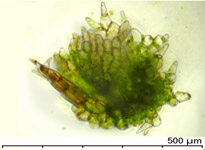
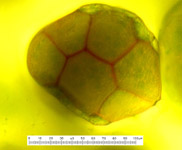 Blasia pusilla gemmae; left: from dorsal surface, right: from flask. Sutton Beach, Lane Co., Oregon. DHW m2412.
Blasia pusilla gemmae; left: from dorsal surface, right: from flask. Sutton Beach, Lane Co., Oregon. DHW m2412.
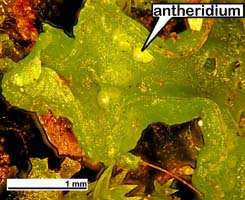 Male branch. Sutton Beach, Lane Co., Oregon. DHW m2412.
Male branch. Sutton Beach, Lane Co., Oregon. DHW m2412.